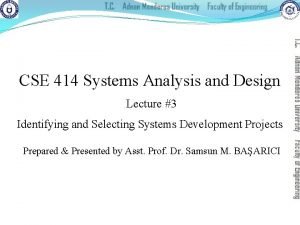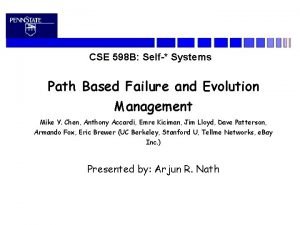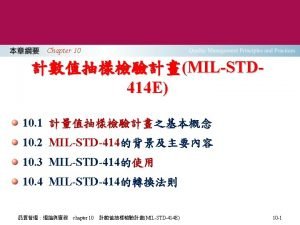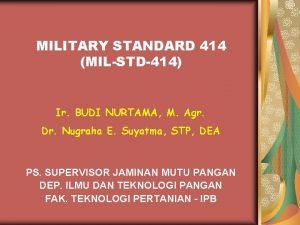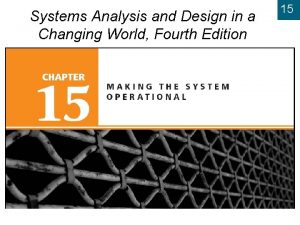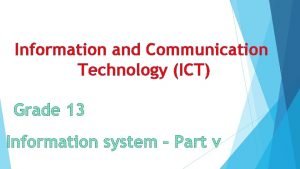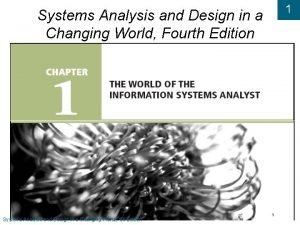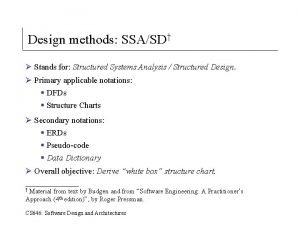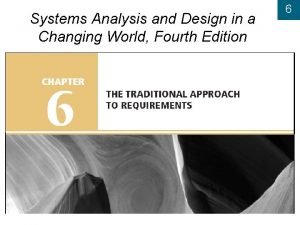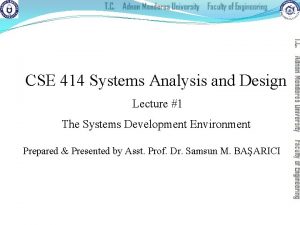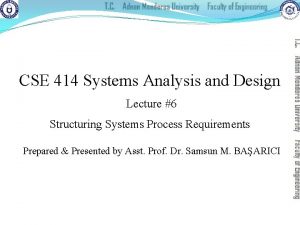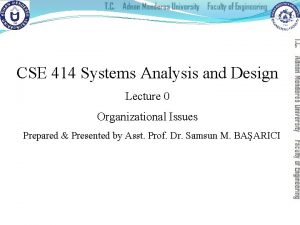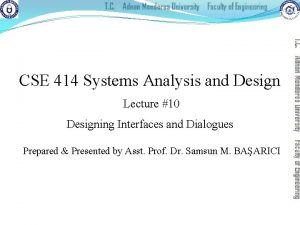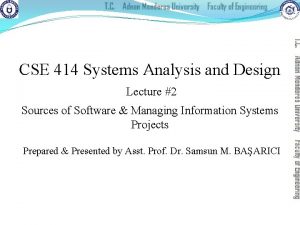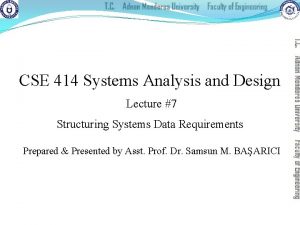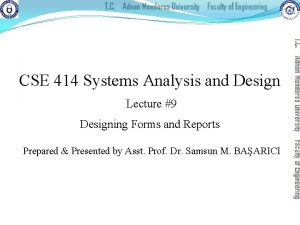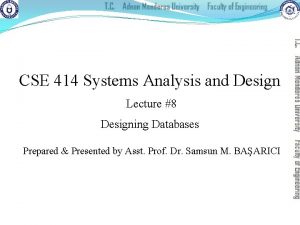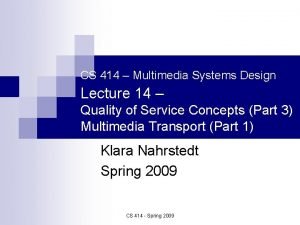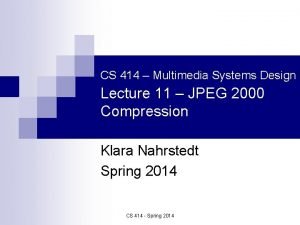CSE 414 Systems Analysis and Design Lecture 3
















































- Slides: 48

CSE 414 Systems Analysis and Design Lecture #3 Identifying and Selecting Systems Development Projects Prepared & Presented by Asst. Prof. Dr. Samsun M. BAŞARICI

Learning Objectives üDescribe the project identification and selection process. üDescribe corporate strategic planning and information systems planning process. üDescribe three classes of Internet electronic commerce applications: business-to-consumer, business-to-employee, and business-to-business. Lecture #3 Identifying and Selecting Systems Development Projects 2

Identifying and Selecting Systems Development Projects FIGURE 4 -1 Systems development life cycle with project identification and selection highlighted Three main steps: 1. Identifying potential development projects 2. Classifying and ranking IS development projects 3. Selecting IS development projects Lecture #3 Identifying and Selecting Systems Development Projects 3

The Process of Identifying and Selecting IS Development Projects 1. Identifying potential development projects � Identification from a stakeholder group � Each stakeholder group brings their own perspective and motivation to the IS decision. Lecture #3 Identifying and Selecting Systems Development Projects 4

The Process of Identifying and Selecting IS Development Projects (Cont. ) � Top-down source are projects identified by top management or by a diverse steering committee. � Bottom-up source are project initiatives stemming from managers, business units, or the development group. � The process varies substantially across organizations. Lecture #3 Identifying and Selecting Systems Development Projects 5

The Process of Identifying and Selecting IS Development Projects (Cont. ) Lecture #3 Identifying and Selecting Systems Development Projects 6

The Process of Identifying and Selecting IS Development Projects (Cont. ) 2. Classifying and ranking IS development projects � Using value chain analysis or other evaluation criteria § Value chain analysis: Analyzing an organization’s activities to determine where value is added to products and/or services and the costs incurred for doing so; usually also includes a comparison with the activities, added value, and costs of other organizations for the purpose of making improvements in the organization’s operations and performance Lecture #3 Identifying and Selecting Systems Development Projects 7

The Process of Identifying and Selecting IS Development Projects (Cont. ) FIGURE 4 -2 Organizations can be thought of as a value chain, transforming raw materials into products for customers Lecture #3 Identifying and Selecting Systems Development Projects 8

The Process of Identifying and Selecting IS Development Projects (Cont. ) Lecture #3 Identifying and Selecting Systems Development Projects 9

The Process of Identifying and Selecting IS Development Projects (Cont. ) 3. Selecting IS development projects � Based on various factors � Both short- and long-term projects considered � Most likely to achieve business objectives selected � A very important and ongoing activity Lecture #3 Identifying and Selecting Systems Development Projects 10

The Process of Identifying and Selecting IS Development Projects (Cont. ) FIGURE 4 -3 Project selection decisions must consider numerous factors and can have numerous outcomes Lecture #3 Identifying and Selecting Systems Development Projects 11

The Process of Identifying and Selecting IS Development Projects (Cont. ) § One method for deciding among different projects or alternative designs: � For each requirement or constraint: Score = weight X rating � Each alternative: sum scores across requirements/constraints � Alternative with highest score wins Lecture #3 Identifying and Selecting Systems Development Projects 12

The Process of Identifying and Selecting IS Development Projects (Cont. ) FIGURE 4 -4 Alternative projects and system design decisions can be assisted using weighted multicriteria analysis Lecture #3 Identifying and Selecting Systems Development Projects 13

Deliverables and Outcomes § Primary deliverable from the first part of the planning phase is a schedule of specific IS development projects. § Outcome of the next part of the planning phase— project initiation and planning—is the assurance that careful consideration was given to project selection and each project can help the organization reach its goals. Lecture #3 Identifying and Selecting Systems Development Projects 14

Deliverables and Outcomes (Cont. ) § Incremental commitment: a strategy in systems analysis and design in which the project is reviewed after each phase and continuation of the project is rejustified Lecture #3 Identifying and Selecting Systems Development Projects 15

Deliverables and Outcomes (Cont. ) Figure 4 -5 Information systems development projects come from both top-down and bottom-up initiatives. Lecture #3 Identifying and Selecting Systems Development Projects 16

Corporate and Information Systems Planning § To benefit from a planning-based approach for identifying and selecting projects, an organization must: � Analyze its information needs thoroughly. � Plan its projects carefully. Lecture #3 Identifying and Selecting Systems Development Projects 17

Reasons for Importance of Improved Planning § Increasing cost of information systems (40% of organizational expense) § Lack of cross-organizational applications and systems § Systems don’t address critical strategic problems § Too much data redundancy, lack of data quality § High system maintenance costs § Long application backlogs Lecture #3 Identifying and Selecting Systems Development Projects 18

Corporate Strategic Planning § Ongoing process that defines mission, objectives, and strategies of an organization § Corporate strategy involves: �Mission statement �Objective statements �Description of competitive strategy Figure 4 -6 Corporate strategic planning is a three step Process. Lecture #3 Identifying and Selecting Systems Development Projects 19

Corporate Strategic Planning (Cont. ) § Mission statement: a statement that makes it clear what business a company is in Figure 4 -7 Mission statement (Pine Valley Furniture) Lecture #3 Identifying and Selecting Systems Development Projects 20

Corporate Strategic Planning (Cont. ) § Objective statement: a series of statements that express an organization’s qualitative and quantitative goals for reaching a desired future position § Sometimes called “critical success factors” Lecture #3 Identifying and Selecting Systems Development Projects 21

Corporate Strategic Planning (Cont. ) FIGURE 4 -8 Statement of Corporate Objectives (Pine Valley Furniture) Lecture #3 Identifying and Selecting Systems Development Projects 22

Corporate Strategic Planning (Cont. ) § Competitive strategy: the method by which an organization attempts to achieve its mission and objectives § Main types: �Low-cost producer �Product differentiation �Product focus or niche Lecture #3 Identifying and Selecting Systems Development Projects 23

Corporate Strategic Planning (Cont. ) Lecture #3 Identifying and Selecting Systems Development Projects 24

Information Systems Planning (ISP) § An orderly means of assessing the information needs of an organization and defining the systems, databases, and technologies that will best meet those needs § ISP must be done in accordance with the organization’s mission, objectives, and competitive strategy. Lecture #3 Identifying and Selecting Systems Development Projects 25

Information Systems Planning (Cont. ) FIGURE 4 -10 Parallel activities of corporate strategic planning and information systems planning Lecture #3 Identifying and Selecting Systems Development Projects 26

Information Systems Planning (Cont. ) § Top-down planning attempts to gain a broad understanding of information system needs of the entire organization and offers: �Broader perspective. �Improved integration. �Improved management support. �Better understanding. Lecture #3 Identifying and Selecting Systems Development Projects 27

Information Systems Planning (Cont. ) § Bottom-up planning identifies IS development projects based on solving specific operational business problems or taking advantage of specific opportunities. �Can be faster and less costly, so may be beneficial in certain circumstances. Lecture #3 Identifying and Selecting Systems Development Projects 28

Information Systems Planning (Cont. ) FIGURE 4 -11 Information systems planning information (Pine Valley Furniture) Lecture #3 Identifying and Selecting Systems Development Projects 29

Information Systems Planning (Cont. ) § Functional Decomposition: breaking high-level abstract information into smaller units for more detailed planning Lecture #3 Identifying and Selecting Systems Development Projects 30

Information Systems Planning (Cont. ) FIGURE 4 -12 Functional decomposition of information systems planning information (Pine Valley Furniture) (Source: Microsoft Corporation. ) Lecture #3 Identifying and Selecting Systems Development Projects 31

Information Systems Planning (Cont. ) § IS planning matrices describe relationships between pairs of organizational elements (location, function, business unit, objective, process, data, information system). Lecture #3 Identifying and Selecting Systems Development Projects 32

Types of Planning Matrices �Location-to-Function �Location-to-Unit �Unit-to-Function �Function-to-Objective �Function-to-Process �Function-to-Data Entity �Process-to-Information System �Data Entity-to-Information System �Information System-to. Objective Lecture #3 Identifying and Selecting Systems Development Projects 33

Information Systems Planning (Cont. ) FIGURE 4 -13 Data Entity-to-Function matrix (Pine Valley Furniture) Lecture #3 Identifying and Selecting Systems Development Projects 34

Making Sense of the Matrices § IS planning takes place prior to project identification and selection § “Behind the scenes” analysis § Matrices: as-is (current) and to-be (future, target) § CASE tools help via: �Managing information �Matrix construction �Matrix analysis (affinity clustering) Lecture #3 Identifying and Selecting Systems Development Projects 35

Affinity Clustering § Arranging planning matrix information so that clusters of information with a predetermined level or type of affinity are placed next to each other on a matrix report § Affinity – the extent to which information holds things in common § Example: Function – to – Data entity matrix � Functions using similar data entities placed in adjacent rows � Data entities used in common by processes in adjacent columns Lecture #3 Identifying and Selecting Systems Development Projects 36

Information Systems (IS) Plan FIGURE 4 -16 Systems development projects flow from the information systems plan. Lecture #3 Identifying and Selecting Systems Development Projects 37

IS Plan Components § Organizational Mission, Objectives, and Strategy �Brief description of mission, objectives, and strategy of the organization § Information Inventory �Summary of processes, functions, data entities, and information needs of the enterprise Lecture #3 Identifying and Selecting Systems Development Projects 38

IS Plan Components (Cont. ) § Mission and Objectives of IS �Primary role IS will play in the organization to transform enterprise from current to future state § Constraints on IS Development �Limitations imposed by technology and current levels of financial, technical, and personnel resources Lecture #3 Identifying and Selecting Systems Development Projects 39

IS Plan Components (Cont. ) § Systems Needs and IS Strategy �Summarize overall information systems needs in the company and set long-term (2 -5 year) strategies for filling the needs § Short Term Plan �Detailed inventory of present projects and systems and detailed plan for the current year Lecture #3 Identifying and Selecting Systems Development Projects 40

IS Plan Components (Cont. ) § Conclusions �Unknown but likely events that can affect the plan, presently known business change elements and their impact on the plan Lecture #3 Identifying and Selecting Systems Development Projects 41

Electronic Commerce: Identifying and Selecting Projects Figure 4 -17 Three possible modes of electronic commerce Lecture #3 Identifying and Selecting Systems Development Projects 42

Electronic Commerce Applications and Internet Basics (Cont. ) § Business-to-consumer (B 2 C): electronic commerce between businesses and consumers § Business-to-business (B 2 B): electronic commerce between business partners, such as suppliers and intermediaries § Business-to-employee (B 2 E): electronic commerce between businesses and their employees Lecture #3 Identifying and Selecting Systems Development Projects 43

Electronic Commerce Applications and Internet Basics (Cont. ) § Internet: a large worldwide network of networks that use a common protocol to communicate with each other § Electronic Commerce (EC): Internet-based communication to support day-to-day business activities § Electronic data interchange (EDI): the use of telecommunications technologies to directly transfer business documents between organizations Lecture #3 Identifying and Selecting Systems Development Projects 44

Electronic Commerce Applications and Internet Basics (Cont. ) Lecture #3 Identifying and Selecting Systems Development Projects 45

Summary § In this chapter you learned how to: ü Describe the project identification and selection process. ü Describe corporate strategic planning and information systems planning process. ü Describe three classes of Internet electronic commerce applications: business-to-consumer, business-to-employee, and business-to-business. Lecture #3 Identifying and Selecting Systems Development Projects 46

Next Lecture Initiating and Planning Systems Development Projects Lecture #3 Identifying and Selecting Systems Development Projects 47

References § Joseph S. Valacich, Joey F. George, Modern Systems Analysis and Design, 8 th Global Edition, Pearson, 2016 Lecture #3 Identifying and Selecting Systems Development Projects 48
 Cse414
Cse414 Cse 598 advanced software analysis and design
Cse 598 advanced software analysis and design 01:640:244 lecture notes - lecture 15: plat, idah, farad
01:640:244 lecture notes - lecture 15: plat, idah, farad Gcd of 414 and 662
Gcd of 414 and 662 Systems analysis and design kendall
Systems analysis and design kendall 0 414
0 414 Tabel military standard
Tabel military standard Mil-std-414
Mil-std-414 Pc 414
Pc 414 Cs 414
Cs 414 Cmsc 414
Cmsc 414 Cmsc 414
Cmsc 414 Cmsc 414
Cmsc 414 Cmsc 414
Cmsc 414 Systems analysis and design in an age of options
Systems analysis and design in an age of options Gantt chart system analysis and design
Gantt chart system analysis and design Systems analysis and design in a changing world
Systems analysis and design in a changing world Systems analysis and design in a changing world
Systems analysis and design in a changing world Alan dennis system analysis design
Alan dennis system analysis design Sad system analysis and design
Sad system analysis and design Structured system analysis and design
Structured system analysis and design Modern system analysis and design
Modern system analysis and design Modern systems analysis and design
Modern systems analysis and design Kendall & kendall systems analysis and design
Kendall & kendall systems analysis and design Systems analysis and design alan dennis
Systems analysis and design alan dennis Systems analysis and design alan dennis
Systems analysis and design alan dennis Systems analysis and design alan dennis
Systems analysis and design alan dennis Systems analysis and design alan dennis
Systems analysis and design alan dennis Systems analysis and design alan dennis
Systems analysis and design alan dennis Systems analysis and design alan dennis
Systems analysis and design alan dennis Systems analysis and design alan dennis
Systems analysis and design alan dennis Ssadm data flow diagram
Ssadm data flow diagram Radar systems analysis and design using matlab
Radar systems analysis and design using matlab Object-oriented systems analysis and design using uml
Object-oriented systems analysis and design using uml A modern approach to systems analysis and design
A modern approach to systems analysis and design Kendall and kendall system analysis and design
Kendall and kendall system analysis and design System analysis and design in a changing world
System analysis and design in a changing world Systems analysis and design in a changing world
Systems analysis and design in a changing world Systems analysis and design in a changing world
Systems analysis and design in a changing world Systems analysis and design alan dennis
Systems analysis and design alan dennis Systems analysis and design alan dennis
Systems analysis and design alan dennis Systems analysis and design alan dennis
Systems analysis and design alan dennis Modern systems analysis and design 7th edition
Modern systems analysis and design 7th edition Structured system of communication
Structured system of communication Essentials of systems analysis and design
Essentials of systems analysis and design Systems analysis and design in a changing world
Systems analysis and design in a changing world Systems analysis and design alan dennis
Systems analysis and design alan dennis Ssasd
Ssasd System analysis and design in a changing world
System analysis and design in a changing world
